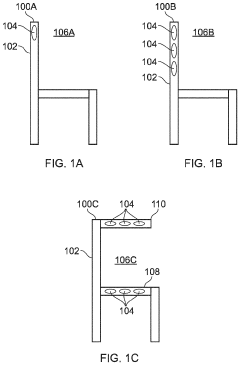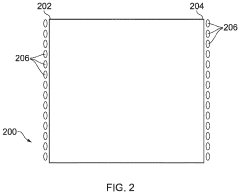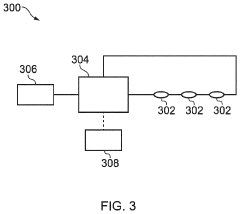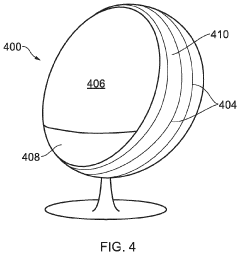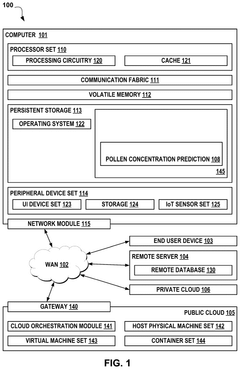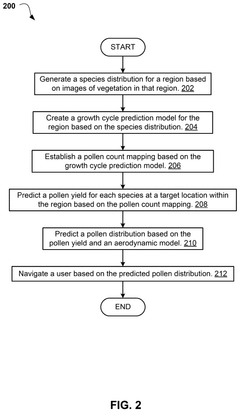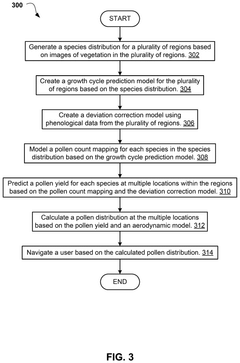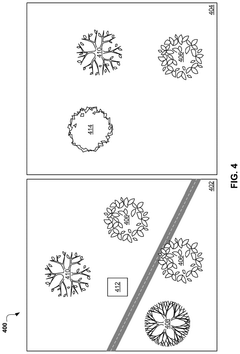Schumann Resonance in the Context of Global Environmental Monitoring
JUN 24, 20259 MIN READ
Generate Your Research Report Instantly with AI Agent
Patsnap Eureka helps you evaluate technical feasibility & market potential.
Schumann Resonance Background and Objectives
Schumann resonances, discovered by physicist Winfried Otto Schumann in 1952, are a set of spectrum peaks in the extremely low frequency (ELF) portion of the Earth's electromagnetic field spectrum. These resonances occur between the Earth's surface and the ionosphere, creating a natural global electromagnetic resonance phenomenon. The fundamental frequency of Schumann resonances is approximately 7.83 Hz, with harmonics at higher frequencies.
The study of Schumann resonances has gained significant attention in recent years due to its potential applications in global environmental monitoring. As these resonances are influenced by various factors such as solar activity, lightning discharges, and ionospheric conditions, they serve as a valuable indicator of global atmospheric and space weather phenomena.
The primary objective of researching Schumann resonances in the context of global environmental monitoring is to develop a comprehensive understanding of the Earth's electromagnetic environment and its interactions with various natural and anthropogenic processes. This research aims to establish a robust framework for utilizing Schumann resonances as a tool for monitoring and predicting changes in the global climate system, ionospheric dynamics, and space weather events.
One of the key goals is to enhance our ability to detect and analyze subtle variations in Schumann resonance parameters, which may be indicative of large-scale environmental changes. By developing advanced measurement techniques and data analysis methods, researchers seek to improve the sensitivity and reliability of Schumann resonance-based monitoring systems.
Another important objective is to investigate the potential correlations between Schumann resonance characteristics and various geophysical phenomena, such as seismic activity, atmospheric electricity, and global temperature variations. This interdisciplinary approach aims to uncover new insights into the complex interactions between different components of the Earth system.
Furthermore, the research seeks to explore the feasibility of using Schumann resonances as a global network of natural electromagnetic sensors for early warning systems. This could potentially aid in the detection and prediction of extreme weather events, ionospheric disturbances, and other natural hazards.
As technology advances, there is also a growing interest in miniaturizing and optimizing Schumann resonance detection systems. This would enable the deployment of a more extensive network of monitoring stations, providing higher spatial and temporal resolution data for global environmental studies.
In the long term, the research on Schumann resonances in global environmental monitoring aims to contribute to our understanding of climate change, space weather forecasting, and the overall health of our planet's electromagnetic ecosystem. By leveraging this natural phenomenon, scientists hope to develop innovative tools and methodologies for sustainable environmental management and disaster mitigation strategies.
The study of Schumann resonances has gained significant attention in recent years due to its potential applications in global environmental monitoring. As these resonances are influenced by various factors such as solar activity, lightning discharges, and ionospheric conditions, they serve as a valuable indicator of global atmospheric and space weather phenomena.
The primary objective of researching Schumann resonances in the context of global environmental monitoring is to develop a comprehensive understanding of the Earth's electromagnetic environment and its interactions with various natural and anthropogenic processes. This research aims to establish a robust framework for utilizing Schumann resonances as a tool for monitoring and predicting changes in the global climate system, ionospheric dynamics, and space weather events.
One of the key goals is to enhance our ability to detect and analyze subtle variations in Schumann resonance parameters, which may be indicative of large-scale environmental changes. By developing advanced measurement techniques and data analysis methods, researchers seek to improve the sensitivity and reliability of Schumann resonance-based monitoring systems.
Another important objective is to investigate the potential correlations between Schumann resonance characteristics and various geophysical phenomena, such as seismic activity, atmospheric electricity, and global temperature variations. This interdisciplinary approach aims to uncover new insights into the complex interactions between different components of the Earth system.
Furthermore, the research seeks to explore the feasibility of using Schumann resonances as a global network of natural electromagnetic sensors for early warning systems. This could potentially aid in the detection and prediction of extreme weather events, ionospheric disturbances, and other natural hazards.
As technology advances, there is also a growing interest in miniaturizing and optimizing Schumann resonance detection systems. This would enable the deployment of a more extensive network of monitoring stations, providing higher spatial and temporal resolution data for global environmental studies.
In the long term, the research on Schumann resonances in global environmental monitoring aims to contribute to our understanding of climate change, space weather forecasting, and the overall health of our planet's electromagnetic ecosystem. By leveraging this natural phenomenon, scientists hope to develop innovative tools and methodologies for sustainable environmental management and disaster mitigation strategies.
Global Environmental Monitoring Market Analysis
The global environmental monitoring market has been experiencing significant growth in recent years, driven by increasing awareness of environmental issues and the need for sustainable development. This market encompasses a wide range of technologies and services aimed at measuring, analyzing, and monitoring various environmental parameters, including air quality, water quality, soil contamination, and climate change indicators.
In the context of Schumann Resonance research for global environmental monitoring, the market shows promising potential. Schumann Resonances, which are electromagnetic resonances in the Earth-ionosphere cavity, have gained attention as a potential indicator of global climate change and other environmental phenomena. This has created a niche market within the broader environmental monitoring sector.
The overall environmental monitoring market is projected to grow steadily over the coming years. Key factors driving this growth include stringent environmental regulations, growing public awareness of environmental issues, and technological advancements in monitoring equipment. The integration of IoT, AI, and big data analytics in environmental monitoring systems is expected to further boost market growth.
Geographically, North America and Europe currently dominate the environmental monitoring market, owing to strict environmental regulations and high adoption rates of advanced monitoring technologies. However, the Asia-Pacific region is expected to witness the highest growth rate in the coming years, driven by rapid industrialization, urbanization, and increasing environmental concerns in countries like China and India.
The Schumann Resonance monitoring segment, while still relatively small, is gaining traction among researchers and environmental agencies. This niche market is expected to grow as more studies establish correlations between Schumann Resonances and global environmental phenomena. The potential applications of Schumann Resonance monitoring in climate change research, earthquake prediction, and global lightning activity tracking are likely to drive demand for specialized monitoring equipment and data analysis services.
Key market players in the environmental monitoring sector include Agilent Technologies, Danaher Corporation, Thermo Fisher Scientific, and Siemens AG. These companies offer a wide range of monitoring solutions, from portable devices to complex integrated systems. In the specific field of Schumann Resonance monitoring, specialized companies and research institutions are emerging as important players, developing custom equipment and analysis tools for this unique application.
The market demand for environmental monitoring solutions, including those related to Schumann Resonance research, is expected to be driven by government initiatives, academic research projects, and private sector investments in environmental sustainability. As the link between global environmental changes and Schumann Resonances becomes more established, it is likely to create new opportunities for innovative monitoring solutions and data analysis services in this specialized field.
In the context of Schumann Resonance research for global environmental monitoring, the market shows promising potential. Schumann Resonances, which are electromagnetic resonances in the Earth-ionosphere cavity, have gained attention as a potential indicator of global climate change and other environmental phenomena. This has created a niche market within the broader environmental monitoring sector.
The overall environmental monitoring market is projected to grow steadily over the coming years. Key factors driving this growth include stringent environmental regulations, growing public awareness of environmental issues, and technological advancements in monitoring equipment. The integration of IoT, AI, and big data analytics in environmental monitoring systems is expected to further boost market growth.
Geographically, North America and Europe currently dominate the environmental monitoring market, owing to strict environmental regulations and high adoption rates of advanced monitoring technologies. However, the Asia-Pacific region is expected to witness the highest growth rate in the coming years, driven by rapid industrialization, urbanization, and increasing environmental concerns in countries like China and India.
The Schumann Resonance monitoring segment, while still relatively small, is gaining traction among researchers and environmental agencies. This niche market is expected to grow as more studies establish correlations between Schumann Resonances and global environmental phenomena. The potential applications of Schumann Resonance monitoring in climate change research, earthquake prediction, and global lightning activity tracking are likely to drive demand for specialized monitoring equipment and data analysis services.
Key market players in the environmental monitoring sector include Agilent Technologies, Danaher Corporation, Thermo Fisher Scientific, and Siemens AG. These companies offer a wide range of monitoring solutions, from portable devices to complex integrated systems. In the specific field of Schumann Resonance monitoring, specialized companies and research institutions are emerging as important players, developing custom equipment and analysis tools for this unique application.
The market demand for environmental monitoring solutions, including those related to Schumann Resonance research, is expected to be driven by government initiatives, academic research projects, and private sector investments in environmental sustainability. As the link between global environmental changes and Schumann Resonances becomes more established, it is likely to create new opportunities for innovative monitoring solutions and data analysis services in this specialized field.
Current State and Challenges in Schumann Resonance Detection
The current state of Schumann Resonance (SR) detection has seen significant advancements in recent years, yet it still faces several challenges. Modern detection systems have improved sensitivity and accuracy, allowing for more precise measurements of the Earth's electromagnetic resonances. However, the inherently weak nature of SR signals continues to pose difficulties in their detection and analysis.
One of the primary challenges in SR detection is the presence of anthropogenic electromagnetic noise. As human activities and technological advancements increase, so does the electromagnetic interference, making it harder to isolate and measure the natural SR signals. This is particularly problematic in urban areas and regions with high industrial activity, necessitating the establishment of remote monitoring stations in less populated areas.
Another significant challenge is the need for long-term, continuous monitoring to capture the full spectrum of SR variations. These variations can be influenced by solar activity, seasonal changes, and even daily fluctuations in the Earth's ionosphere. Maintaining consistent, high-quality data collection over extended periods requires robust equipment and reliable power sources, which can be challenging in remote locations.
The interpretation of SR data also presents difficulties. While the relationship between SR and various environmental factors is well-established, the complex interplay of these factors makes it challenging to isolate specific causes for observed changes. This complexity necessitates sophisticated data analysis techniques and models to extract meaningful information from the SR measurements.
Furthermore, the global nature of SR phenomena requires a coordinated international effort for comprehensive monitoring. Currently, there is a lack of standardization in measurement techniques and data reporting across different research groups and countries. This inconsistency can lead to difficulties in comparing and integrating data from various sources, hindering global-scale analysis.
Technological limitations also persist in SR detection equipment. While advancements have been made, there is still room for improvement in sensor sensitivity, noise reduction techniques, and data processing algorithms. The development of more compact, energy-efficient, and cost-effective detection systems could greatly enhance the global coverage of SR monitoring networks.
Despite these challenges, the potential of SR as a tool for global environmental monitoring continues to drive research and innovation in this field. Overcoming these obstacles will be crucial for fully leveraging SR data in understanding and predicting global environmental phenomena, from climate change to seismic activity.
One of the primary challenges in SR detection is the presence of anthropogenic electromagnetic noise. As human activities and technological advancements increase, so does the electromagnetic interference, making it harder to isolate and measure the natural SR signals. This is particularly problematic in urban areas and regions with high industrial activity, necessitating the establishment of remote monitoring stations in less populated areas.
Another significant challenge is the need for long-term, continuous monitoring to capture the full spectrum of SR variations. These variations can be influenced by solar activity, seasonal changes, and even daily fluctuations in the Earth's ionosphere. Maintaining consistent, high-quality data collection over extended periods requires robust equipment and reliable power sources, which can be challenging in remote locations.
The interpretation of SR data also presents difficulties. While the relationship between SR and various environmental factors is well-established, the complex interplay of these factors makes it challenging to isolate specific causes for observed changes. This complexity necessitates sophisticated data analysis techniques and models to extract meaningful information from the SR measurements.
Furthermore, the global nature of SR phenomena requires a coordinated international effort for comprehensive monitoring. Currently, there is a lack of standardization in measurement techniques and data reporting across different research groups and countries. This inconsistency can lead to difficulties in comparing and integrating data from various sources, hindering global-scale analysis.
Technological limitations also persist in SR detection equipment. While advancements have been made, there is still room for improvement in sensor sensitivity, noise reduction techniques, and data processing algorithms. The development of more compact, energy-efficient, and cost-effective detection systems could greatly enhance the global coverage of SR monitoring networks.
Despite these challenges, the potential of SR as a tool for global environmental monitoring continues to drive research and innovation in this field. Overcoming these obstacles will be crucial for fully leveraging SR data in understanding and predicting global environmental phenomena, from climate change to seismic activity.
Existing Schumann Resonance Monitoring Solutions
01 Schumann resonance devices for health and wellness
Various devices are designed to generate or utilize Schumann resonance frequencies for potential health benefits. These devices aim to simulate the natural electromagnetic frequencies of the Earth to promote relaxation, improve sleep quality, and enhance overall well-being. Some implementations include wearable devices, room-based generators, and portable units that emit Schumann resonance frequencies.- Schumann resonance devices for health and wellness: Various devices are designed to generate or utilize Schumann resonance frequencies for potential health benefits. These devices aim to simulate the natural electromagnetic frequencies of the Earth to promote relaxation, improve sleep quality, and enhance overall well-being. Some implementations include wearable devices, room-based generators, and portable units that emit Schumann resonance frequencies.
- Integration of Schumann resonance in therapeutic applications: Schumann resonance is incorporated into various therapeutic applications and medical devices. These applications may include stress reduction, pain management, and improving cognitive function. Some devices combine Schumann resonance with other therapies such as light therapy, sound therapy, or magnetic field therapy to enhance their effectiveness.
- Schumann resonance in environmental and atmospheric monitoring: Devices and systems are developed to detect and measure Schumann resonance for environmental and atmospheric monitoring purposes. These technologies can be used to study global lightning activity, climate change effects, and ionospheric conditions. Some implementations include sensor networks and data analysis systems for real-time monitoring of Schumann resonance variations.
- Schumann resonance generators for agricultural applications: Schumann resonance generators are designed for use in agriculture to potentially improve crop growth and soil health. These devices aim to simulate natural electromagnetic conditions that may enhance plant growth, increase crop yield, and improve soil microbial activity. Some implementations include portable generators for field use and larger systems for greenhouse applications.
- Schumann resonance in electromagnetic shielding and protection: Technologies are developed to incorporate Schumann resonance in electromagnetic shielding and protection devices. These innovations aim to protect electronic equipment and living organisms from harmful electromagnetic radiation while maintaining exposure to beneficial Schumann resonance frequencies. Some implementations include specialized materials and structures for buildings, vehicles, and personal protective equipment.
02 Schumann resonance in environmental monitoring and research
Schumann resonance is utilized in environmental monitoring and research applications. Devices and systems are developed to measure and analyze these resonances for studying global lightning activity, climate change, and ionospheric conditions. These technologies may include sensitive antennas, signal processing equipment, and data analysis software to detect and interpret Schumann resonance signals.Expand Specific Solutions03 Integration of Schumann resonance in meditation and relaxation products
Schumann resonance frequencies are incorporated into meditation and relaxation products to enhance the user experience. These products may include specialized audio systems, meditation cushions, or relaxation pods that generate or amplify Schumann resonance frequencies. The aim is to create an environment that aligns with the Earth's natural frequencies for deeper relaxation and potentially improved meditation practices.Expand Specific Solutions04 Schumann resonance in agricultural and plant growth applications
Applications of Schumann resonance in agriculture and plant growth are explored. Devices and systems are developed to expose plants to Schumann resonance frequencies, potentially enhancing growth, improving crop yields, or increasing plant resilience. These technologies may include specialized growth chambers, field-based emitters, or integrated greenhouse systems that generate or amplify these frequencies.Expand Specific Solutions05 Schumann resonance in electromagnetic shielding and protection
Schumann resonance principles are applied in developing electromagnetic shielding and protection technologies. These innovations aim to protect sensitive equipment or living spaces from harmful electromagnetic frequencies while maintaining or enhancing the beneficial Schumann resonance frequencies. Applications may include specialized building materials, protective clothing, or electronic devices designed to filter and balance electromagnetic fields.Expand Specific Solutions
Key Players in Schumann Resonance Research
The research on Schumann Resonance for global environmental monitoring is in its early development stage, with a growing market as environmental concerns increase. The technology's maturity varies among key players. Companies like IBM, Nokia, and Sony are leveraging their technological expertise to advance the field. Universities such as National Taiwan University and the University of Bern are contributing fundamental research. Environmental monitoring firms like Aclima and Earth Networks are integrating Schumann Resonance into their solutions. Research institutions such as Korea Institute of Geoscience & Mineral Resources are exploring practical applications. The diverse range of players, from tech giants to specialized environmental firms, indicates a competitive landscape with significant potential for innovation and market growth.
International Business Machines Corp.
Technical Solution: IBM has developed a sophisticated environmental monitoring system that leverages Schumann Resonance (SR) data for global climate analysis. Their approach combines advanced sensor networks with AI-powered data processing to detect subtle changes in SR patterns. This system integrates data from multiple sources, including ground-based ELF receivers and satellite observations, to create a comprehensive picture of global electromagnetic activity. IBM's solution uses machine learning algorithms to identify correlations between SR variations and various environmental phenomena, such as severe weather events, seismic activity, and ionospheric disturbances.
Strengths: Robust data integration capabilities, advanced AI analytics, and global reach. Weaknesses: High implementation costs and potential over-reliance on complex algorithms that may require frequent calibration.
The Boeing Co.
Technical Solution: Boeing has developed an innovative airborne Schumann Resonance monitoring system for environmental research. This system utilizes specially equipped aircraft to measure SR frequencies at various altitudes, providing a unique three-dimensional perspective on global electromagnetic phenomena. Boeing's approach combines high-sensitivity ELF antennas with advanced signal processing techniques to filter out aircraft-induced electromagnetic noise. The collected data is then integrated with ground-based measurements to create a more comprehensive understanding of SR variations and their relationship to global environmental changes.
Strengths: Unique airborne measurement capability, potential for global coverage, and integration with existing atmospheric research programs. Weaknesses: Limited continuous monitoring due to flight constraints and potentially high operational costs.
Core Innovations in Schumann Resonance Detection
A magnetic field exposure system and uses thereof
PatentPendingUS20230372726A1
Innovation
- A magnetic field exposure system generating an amplitude-modulated low frequency magnetic field with a carrier frequency of 360 to 450 Hz and a modulation frequency of 0.5 to 100 Hz, providing a field strength of 0.5 to 250 μT, specifically designed to enhance cell survival, proliferation, reduce stress, and promote tissue regeneration.
Internet-of-things-based allergen pollen concentration prediction
PatentPendingUS20250089638A1
Innovation
- A system that uses existing IoT sensors and phenological data to identify plant species, model growth cycles, predict pollen yields, and calculate pollen distribution, allowing for real-time, granular assessments of allergen concentrations, enabling users to navigate around specific allergens.
Climate Change Impact on Schumann Resonance
Climate change has emerged as a significant factor influencing the Schumann Resonance, a set of spectral peaks in the Earth's electromagnetic field spectrum. As global temperatures rise and weather patterns shift, these changes are reflected in the characteristics of the Schumann Resonance, making it a potential indicator of climate change impacts.
The primary mechanism through which climate change affects the Schumann Resonance is through alterations in global lightning activity. As temperatures increase, the frequency and intensity of thunderstorms are expected to change, directly impacting the excitation of the Earth-ionosphere cavity that produces the Schumann Resonance. Studies have shown that warmer temperatures generally lead to increased lightning activity, which in turn can amplify the Schumann Resonance signal.
Furthermore, changes in atmospheric composition due to climate change can influence the propagation of electromagnetic waves within the Earth-ionosphere waveguide. Increased levels of greenhouse gases and changes in water vapor content can alter the electrical properties of the atmosphere, potentially affecting the frequency and amplitude of the Schumann Resonance.
The melting of polar ice caps and rising sea levels, both consequences of global warming, may also play a role in modifying the Schumann Resonance. These changes in the Earth's surface conditions can affect the global electric circuit, which is intimately connected to the generation and propagation of the Schumann Resonance.
Researchers have observed long-term trends in Schumann Resonance parameters that correlate with global temperature changes. For instance, some studies have reported a slight increase in the fundamental Schumann Resonance frequency over the past few decades, which may be linked to global warming effects on the Earth's atmosphere.
The potential of the Schumann Resonance as a climate change indicator has sparked interest in its long-term monitoring. Continuous measurements of Schumann Resonance parameters at multiple locations around the globe could provide valuable insights into global climate dynamics and help validate climate models.
However, it is important to note that the relationship between climate change and the Schumann Resonance is complex and not yet fully understood. Other factors, such as solar activity and geomagnetic disturbances, also influence the Schumann Resonance, making it challenging to isolate the specific effects of climate change. Ongoing research aims to disentangle these various influences and develop more robust methods for using Schumann Resonance data in climate change studies.
The primary mechanism through which climate change affects the Schumann Resonance is through alterations in global lightning activity. As temperatures increase, the frequency and intensity of thunderstorms are expected to change, directly impacting the excitation of the Earth-ionosphere cavity that produces the Schumann Resonance. Studies have shown that warmer temperatures generally lead to increased lightning activity, which in turn can amplify the Schumann Resonance signal.
Furthermore, changes in atmospheric composition due to climate change can influence the propagation of electromagnetic waves within the Earth-ionosphere waveguide. Increased levels of greenhouse gases and changes in water vapor content can alter the electrical properties of the atmosphere, potentially affecting the frequency and amplitude of the Schumann Resonance.
The melting of polar ice caps and rising sea levels, both consequences of global warming, may also play a role in modifying the Schumann Resonance. These changes in the Earth's surface conditions can affect the global electric circuit, which is intimately connected to the generation and propagation of the Schumann Resonance.
Researchers have observed long-term trends in Schumann Resonance parameters that correlate with global temperature changes. For instance, some studies have reported a slight increase in the fundamental Schumann Resonance frequency over the past few decades, which may be linked to global warming effects on the Earth's atmosphere.
The potential of the Schumann Resonance as a climate change indicator has sparked interest in its long-term monitoring. Continuous measurements of Schumann Resonance parameters at multiple locations around the globe could provide valuable insights into global climate dynamics and help validate climate models.
However, it is important to note that the relationship between climate change and the Schumann Resonance is complex and not yet fully understood. Other factors, such as solar activity and geomagnetic disturbances, also influence the Schumann Resonance, making it challenging to isolate the specific effects of climate change. Ongoing research aims to disentangle these various influences and develop more robust methods for using Schumann Resonance data in climate change studies.
Data Integration and Interpretation Challenges
The integration and interpretation of Schumann Resonance (SR) data for global environmental monitoring present significant challenges due to the complexity and variability of the signals. One primary obstacle is the need to distinguish between natural SR fluctuations and those caused by anthropogenic activities or environmental changes. This requires sophisticated signal processing techniques and advanced algorithms to filter out noise and isolate relevant data patterns.
Another challenge lies in the integration of SR data with other environmental monitoring systems. SR measurements must be correlated with data from various sources, such as satellite imagery, ground-based sensors, and atmospheric models. This multi-dimensional data integration demands robust data management systems and standardized protocols to ensure compatibility and accuracy across different platforms and measurement techniques.
The interpretation of SR data in the context of global environmental monitoring is further complicated by the need to account for spatial and temporal variations. SR signals can be influenced by local geological features, ionospheric conditions, and global weather patterns. Developing models that can accurately interpret these variations and their implications for environmental monitoring requires extensive cross-disciplinary collaboration and continuous refinement of analytical methods.
Data quality and consistency pose additional challenges. SR monitoring stations are distributed globally, often in remote locations, which can lead to discrepancies in data collection methods and equipment calibration. Ensuring data integrity and comparability across different monitoring sites is crucial for drawing meaningful conclusions about global environmental trends.
The sheer volume of data generated by continuous SR monitoring also presents significant storage and processing challenges. Real-time analysis of SR data for environmental monitoring applications requires high-performance computing infrastructure and efficient data transmission networks. Developing scalable solutions for data storage, retrieval, and analysis is essential for leveraging the full potential of SR in global environmental monitoring efforts.
Lastly, the interpretation of SR data in the context of environmental monitoring requires a nuanced understanding of the complex interactions between the Earth's electromagnetic field, the ionosphere, and various environmental factors. This necessitates ongoing research to refine our understanding of these relationships and develop more accurate interpretative frameworks for SR data in environmental monitoring applications.
Another challenge lies in the integration of SR data with other environmental monitoring systems. SR measurements must be correlated with data from various sources, such as satellite imagery, ground-based sensors, and atmospheric models. This multi-dimensional data integration demands robust data management systems and standardized protocols to ensure compatibility and accuracy across different platforms and measurement techniques.
The interpretation of SR data in the context of global environmental monitoring is further complicated by the need to account for spatial and temporal variations. SR signals can be influenced by local geological features, ionospheric conditions, and global weather patterns. Developing models that can accurately interpret these variations and their implications for environmental monitoring requires extensive cross-disciplinary collaboration and continuous refinement of analytical methods.
Data quality and consistency pose additional challenges. SR monitoring stations are distributed globally, often in remote locations, which can lead to discrepancies in data collection methods and equipment calibration. Ensuring data integrity and comparability across different monitoring sites is crucial for drawing meaningful conclusions about global environmental trends.
The sheer volume of data generated by continuous SR monitoring also presents significant storage and processing challenges. Real-time analysis of SR data for environmental monitoring applications requires high-performance computing infrastructure and efficient data transmission networks. Developing scalable solutions for data storage, retrieval, and analysis is essential for leveraging the full potential of SR in global environmental monitoring efforts.
Lastly, the interpretation of SR data in the context of environmental monitoring requires a nuanced understanding of the complex interactions between the Earth's electromagnetic field, the ionosphere, and various environmental factors. This necessitates ongoing research to refine our understanding of these relationships and develop more accurate interpretative frameworks for SR data in environmental monitoring applications.
Unlock deeper insights with Patsnap Eureka Quick Research — get a full tech report to explore trends and direct your research. Try now!
Generate Your Research Report Instantly with AI Agent
Supercharge your innovation with Patsnap Eureka AI Agent Platform!
